TRAINING NOTEBOOK ❘ By ADAM HAYWOOD
Battery-powered tools have become an integral part of the modern fire service, earning their place on many frontline fire apparatus. Historically, anything battery-powered was relegated to the usual complement of a firefighter’s flashlight and homeowner-grade tools such as drills/drivers, grinders, reciprocating saws, and so on. However, with lithium-ion battery technology evolving at an incredible pace and manufacturers beginning to produce more mission-specific tools, we are now beginning to see a more diverse range of tools that can accomplish a wider array of tasks on the fireground.
One such tool to enter the conversation in the past few years is the battery-powered nine-inch cutoff saw. The latest iteration of a truck company favorite—the rotary saw—has now been slimmed down into a smaller, lighter, and quieter package with innovative brushless electric motor technology powering the saw instead of the classic 70- to 100-cc gasoline-powered engine. Whereas traditional rotary saws run 12- to 16-inch blades on either a 20-millimeter or one-inch arbor, this new generation of saws runs a smaller nine-inch blade on a 7⁄8-inch arbor.
By no means are these new-age saws designed to take the place of the gas-powered rotary saw; they each have their place on the truck. What these new smaller, battery-powered saws have done, however, is reimagine how firefighters approach light-duty forcible entry challenges and challenge fire departments to rethink their tool selection for less-traditional rigs such as squads, brush trucks, and even medic units.
The Basics
Lightweight and extremely portable, the new nine-inch battery saws are becoming a favorite for firefighters looking to force entry through obstacles such as padlocks, deadbolts, chains, fences, vehicles, and more. Most manufacturers’ saws weigh anywhere from 7.7 to 10.8 pounds as a bare tool and only a few more pounds more when you add the battery and either an abrasive or diamond blade, the two primary blade choices on the market. This small, lightweight package enables firefighters to make cuts at awkward heights and angles; working from ground and aerial ladders; in tight quarters; and even indoors, where a more traditional rotary saw could prove too cumbersome or even dangerous to operate. Battery-powered saws allow for safer usage indoors and in poorly ventilated areas since they do not produce carbon monoxide like a traditional gas-powered saw.
This saw is so maneuverable, a large fire department in South Florida recently outfitted its fleet with nine-inch battery saws to specifically tackle second-story vent-enter-search obstacles. During extensive training on several acquired structures equipped with impact- resistant windows, this department came to realize it was much safer to operate the smaller, lighter, battery-powered saw from a ground ladder vs. the more unwieldly 14-inch gas-powered saw. In this case, data collected from hands-on training and local building codes helped this department justify the expense to equip every suppression unit with a nine-inch battery-powered saw.
Another benefit of their compact size is their ability to fit more easily onto smaller apparatus. It is not uncommon to now find these saws on rigs that traditionally never carried any battery-powered tools. Some departments are now equipping their medic units with these saws to expand and improve their combat effectiveness on scene.
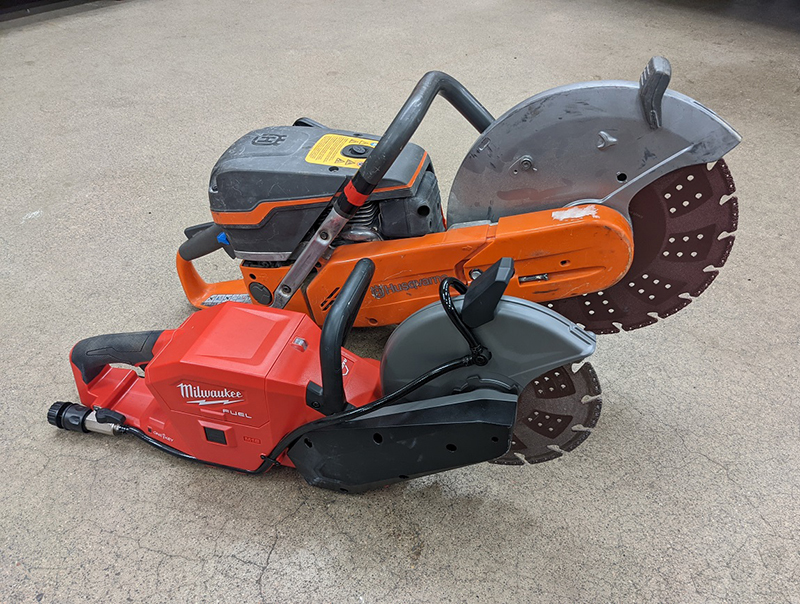
(1) Size comparison of a nine-inch battery saw vs. a 14-inch gas-powered rotary saw. (Photos by author unless otherwise noted.)

(2) Testing a nine-inch battery saw’s ability to cut drop-bar bolts.
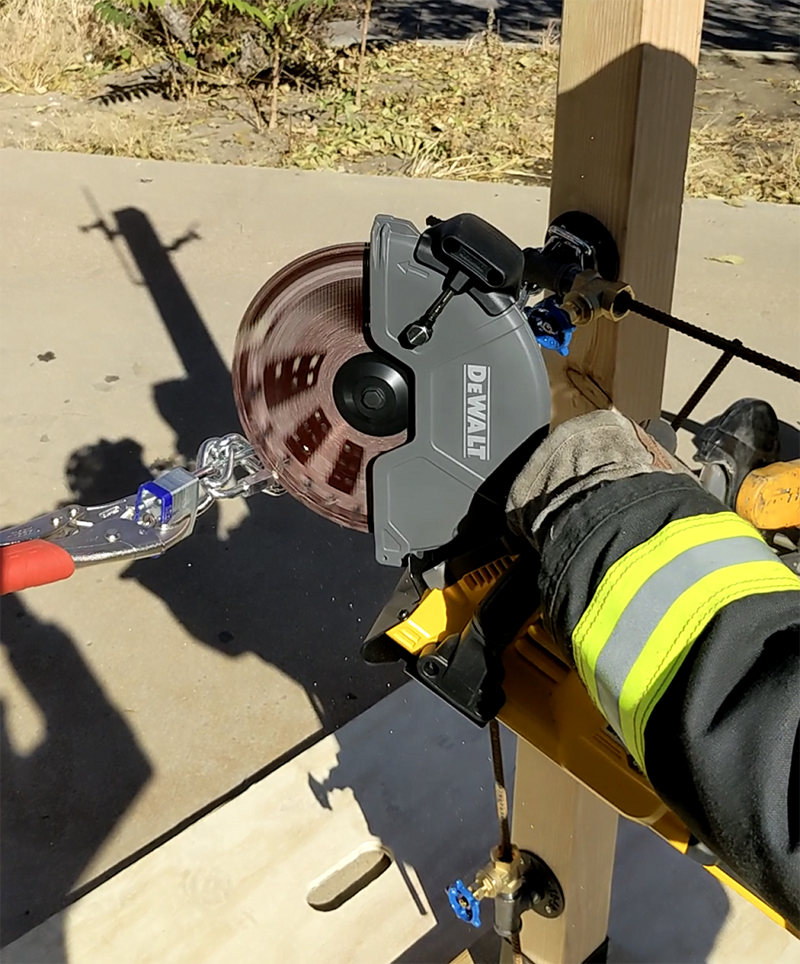
(3) Cutting a 5⁄16-inch chain for product testing.
New Features
Although, from the outside, these saws might just look like a scaled-down version of a rotary saw, they come with a host of new features never before seen on a rotary saw—arguably, the most important being the new electric blade brake. One of the biggest safety issues with a traditional rotary saw is the lack of a blade brake. Unless the user buries the blade into the material being cut, a rotary saw’s blade must spin down by itself to stop. According to an article by Miami-Dade (FL) Fire Rescue Captain Bill Gustin, the primary cause of injury with rotary saws is accidental contact with the spinning blade. This concern is practically eliminated with the new battery saws. Using the motor itself as a resistor, every manufacturer now touts a blade brake time of four seconds or quicker after releasing the trigger.
An additional safety feature found on most battery saws is the load indicator light. This light is easily visible during operation and will alert users when they are overloading the saw, which can shorten equipment and battery life and can be remedied by easing up on the saw and resuming the cut with less applied pressure, letting the blade do the work. If the operator continues to use the saw despite the warning light being illuminated, the saw may shut down as a safeguard. If this occurs, remove the saw from the cut and restart the cut.
Limitations
These saws are not without their own unique set of drawbacks. One of their biggest shortcomings is their limited run time. Even the most robust batteries will die long before a tank of gas will run out. Recently, at my department, we ran a research and development trial that pitted two of the most popular nine-inch battery saw manufacturers head-to-head. We cut rebar, padlocks, vehicles, overhead doors, and drop bar doors. During our informal testing, we consistently averaged 20 to 30 minutes of run time per fully charged battery, regardless of the manufacturer. Ultimately, battery run times will vary based on amp-hour rating, charge level, model, and operating conditions. Always remember to have a healthy supply of fresh batteries available on the rig for any extended cutting operations.
If you’re looking to purchase a battery-powered saw, consider battery compatibility from each manufacturer. For example, most departments have already made a significant investment in their preexisting power tool complement (drills, grinders, and so on) for their fleet. If you plan to purchase a battery saw from the same manufacturer as your existing power tool arsenal, it is important to confirm that the batteries are interchangeable with your other tools to avoid additional investment in chargers and batteries. If you choose to purchase a battery saw from a manufacturer different from your power tools, its proprietary batteries will require their own dedicated chargers and could occupy valuable compartment space. This isn’t necessarily a bad thing, just another factor to consider when looking to purchase a new battery-powered saw.
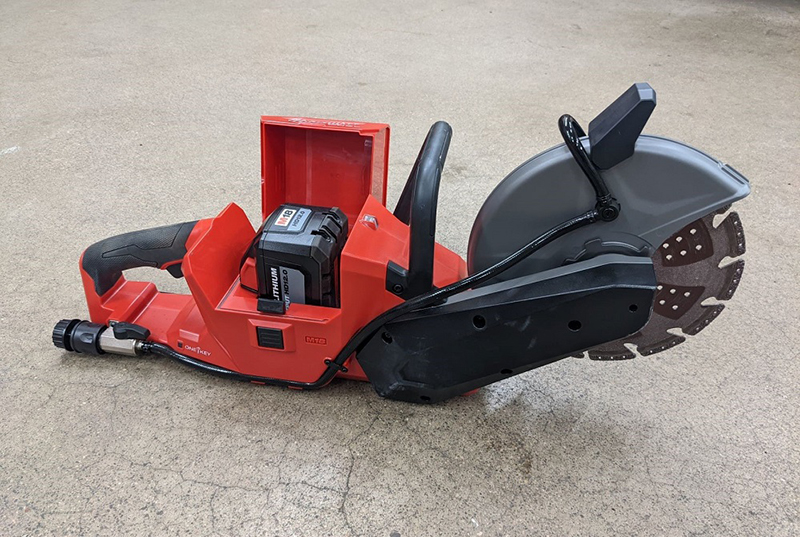
(4, 5) This model of battery saw employs a sealed battery compartment. Although it is protected from the elements, it is more vulnerable to overheating.

(5)
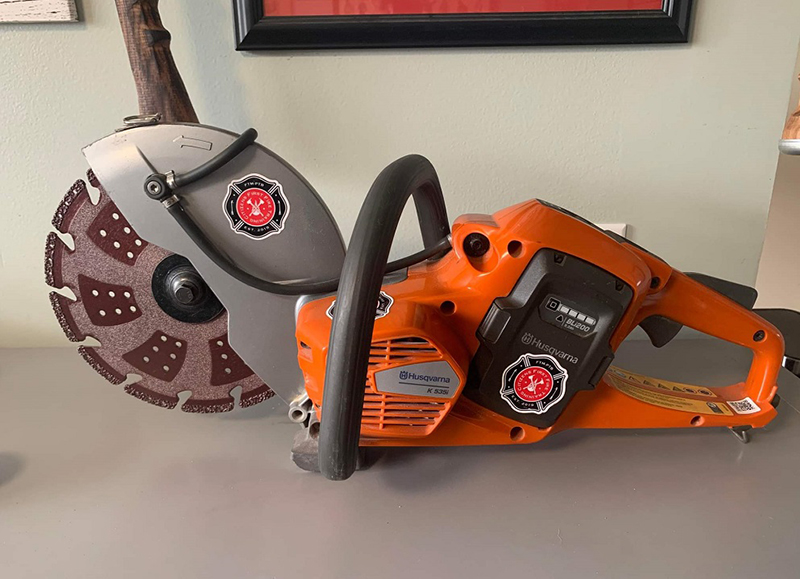
(6, 7) A battery saw with an exposed battery. This design allows for maximum air flow, but it is more susceptible to damage. (Photos by Chris Kessinger.)
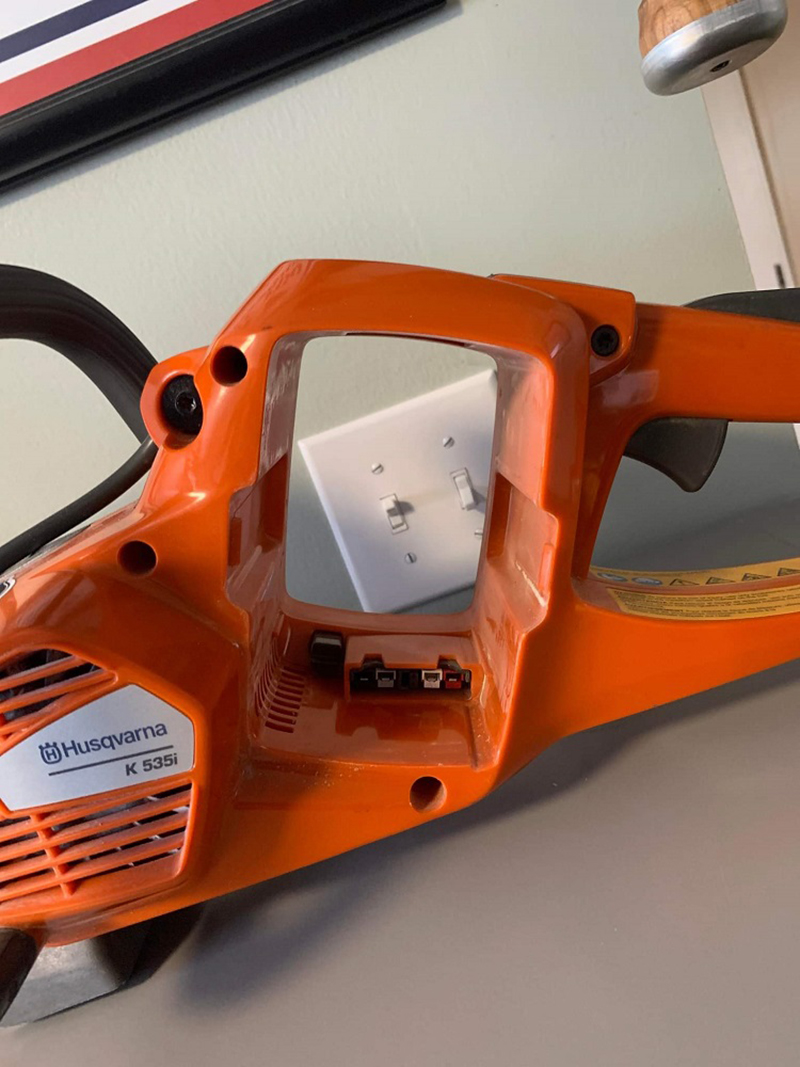
(7)
One of the biggest enemies of a battery is heat. There’s no shortage of heat when it comes to running a cutoff saw hard on scene. Battery-powered saws can be susceptible to overheating and need extra attention when compared to their gas-powered counterparts. Again, be aware of how some manufacturers design their battery compartments, as some models are more apt to overheat than others. Different model saws either place the batteries in a closed compartment or open to the elements; both ways have their advantages and disadvantages. A sealed battery box may protect the battery from the elements better but will offer significantly less airflow and be more prone to overheating. Conversely, batteries open to the elements and not enclosed in a box will offer more airflow but may be damaged more easily.
Nine-inch battery-powered saws are also limited in the depth that they can cut:h 3½ inches of cutting depth is the deepest offered by any manufacturer. Remember, a standard 14-inch blade on a rotary saw will afford you five inches of cutting depth. A nine-inch battery saw might be best left on the rig if you need to cut through any substantial sort of overhead door or commercial roof and there is a gas-powered rotary saw at your disposal. A nine-inch battery-powered saw may absolutely be used in a pinch if that’s all that’s available; it just might take some extra time, effort, and batteries.
Additional Tips
Every nine-inch battery-powered model currently on the market has a water-feed system for dust control when cutting concrete, also known as “wet saw” capability. This makes the current lineup of nine-inch battery saws candidates for use in urban search and rescue and other tech rescue capacities. During the Champlain Towers collapse response, many battery-powered saws were successfully deployed and operated.
For departments on a tight budget, a battery-powered saw may satisfy many operational needs for a fraction of the cost of a new gas-powered rotary saw. Most saw packages, with blades, batteries, and a charger included, cost less than $900. Current prices for a new 14-inch gas-powered rotary saw range anywhere from $1,200 to $1,600.
We are beginning to see 14-inch battery-powered rotary saws enter the market in direct competition with their gas-powered counterparts. Although these 14-inch battery saws are still very new, with only a few manufacturers making them, they are most certainly here to stay. We will almost certainly see a larger number of models and manufacturers in the future as saw and battery technologies progress.
There will almost always be a place in the fire service for gas-powered rotary saws, but they will definitely remain in stiff competition with their battery-powered counterparts. With battery technology improving at an exponential rate, we are fast closing in on the point where battery power will be competitive with gasoline power and may eventually surpass it. Today’s nine-inch battery-powered saws offer many unique advantages and are absolutely earning their place on fire apparatuses across the country.
Author’s note: Every manufacturer on the market now has some sort of battery “fuel gauge” on their battery packs. This technology has been out for some time now, and almost everyone should be familiar with it if you’ve picked up a power tool in the past five years.
Reference
Gustin W. “Care, Maintenance & Operation of Rotary Saws.” Gustin Fire Training. Retrieved from: https://gustinfiretraining.com/care-maintenance-operation-of-rotary-saws.
ADAM HAYWOOD is a 12-year fire service veteran and a firefighter/emergency medical technician for Adams County (CO) Fire Rescue, where he is assigned to Engine Company 13. He also owns and operates Independent Fire Training and has taught as a subject matter expert on various forcible entry disciplines throughout the country.

